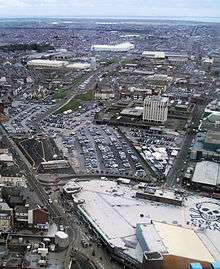Blackpool Central railway station
| Blackpool Central | |
|---|---|
|
Blackpool central railway station - and Blackpool Tower - in 1959 | |
| Location | |
| Place | Blackpool |
| Area | Blackpool |
| Coordinates | 53°48′51″N 3°03′15″W / 53.8141°N 3.0542°WCoordinates: 53°48′51″N 3°03′15″W / 53.8141°N 3.0542°W |
| Operations | |
| Original company | Blackpool and Lytham Railway |
| Pre-grouping | Lancashire and Yorkshire Railway / London and North Western Railway |
| Post-grouping | London, Midland and Scottish Railway |
| Platforms | 14 |
| History | |
| 6 April 1863 | Opened as Hounds Hill |
| June 1878 | Renamed Blackpool Central |
| 1901 | Enlarged to 14 platforms |
| 2 November 1964 | Closed |
| Disused railway stations in the United Kingdom | |
|
Closed railway stations in Britain A B C D–F G H–J K–L M–O P–R S T–V W–Z | |
|
| |
Blackpool Central was the largest railway station in the town of Blackpool in the county of Lancashire, England. When it closed in 1964, it became the station with the highest number of platforms ever to close,[1] comprising 14 platforms. Principal railway services to Blackpool now terminate at Blackpool North.
History
The station opened on 6 April 1863 as "Hounds Hill" and was renamed "Blackpool Central" in 1878.[2] Initially, it was a relatively small town centre terminus for an isolated line running along the south Fylde coast from Lytham. In 1874 this line was connected to another branch from Lytham to Kirkham, allowing through trains from Preston and beyond. In 1901, the station was enlarged to include 14 platforms—the same number of platforms as London's busy Paddington terminus in 2006. A further development came in 1903 when an additional “Marton Line” was added, routed directly from Preston and considerably shorter and quicker.[3][4] This arrangement made for very convenient and direct access to Blackpool's town centre, particularly the sea front and Blackpool Tower.
The station was the world's busiest railway station in 1911.[5]
Central Station was the focus of Blackpool's worst incident during the Second World War. Blackpool was home base for a major flight training centre and a fighter squadron during the war. On 27 August 1941, two aircraft—a Blackburn Botha trainer and a Boulton Paul Defiant fighter—collided in midair over the sea, just off Blackpool's central seafront. The debris from the collision was strewn over a large area but a large part of it struck Central Station, causing severe damage and killing twelve people.[6]
The station remained in service just long enough to see its centenary before its closure on 2 November 1964,[7] against the original recommendation of the 1963 Beeching Plan, which had proposed the closure of Blackpool North station instead.[8] Blackpool Corporation had successfully lobbied British Railways for Central to be closed instead, in order that it may buy the land for potentially lucrative redevelopment.[8]
Part of the building was used as a bingo hall until 1973, at which point all buildings were demolished. The direct “Marton” line from Preston (which also passed through Blackpool South station) was closed in 1965, leaving a large tract of wasteland along with disused embankments and bridges.
Current use of the site

The land reclaimed from the station buildings became the location of some sea front amusement arcades (Coral Island), a new police station and a multi-storey car park with some residual spare land used as additional flat car parking space. In the late 1980s, the derelict track bed of the central railway line was adapted into a road, Yeadon Way, connecting the town centre with the M55 motorway. This road terminates at Blackpool Central Car Park, based at the site of the former platform ends and approach tracks. The main claim to fame for this area is the place in which the Blackpool Illuminations are ceremonially switched on here with a large party and often local and national radio coverage. The very outer wall of the car park is the last visible remnant of the 1900 building. Traces of the infilled platforms can be seen in the ground of the Central car park.
A large part of the sidings and other land formerly belonging to British Rail were converted into a car park at about the same time as the road was completed. The toilets at the end near the promenade along with the aforementioned wall were all that remained of the station. The toilet block was demolished and replaced in 2009. An adjacent building formerly used as a railwaymen's hostel remains and has been converted into flats and shops.
Notes
| Maps showing Blackpool Central Station |
| Old OS Maps (estimated 1925 to 1945) |
| NPE Maps (1947) |
| Vision of Britain |
| OS 1:2500 Map on MARIO (about 1892) |
| Other maps |
- ↑ Beeching-The Inside Track. p. 16. ISBN 978-1-906167-84-4.
- ↑ Welch 2004, p. 32.
- ↑ Suggitt 2004, p. 44.
- ↑ Welch 2004, p. 26.
- ↑ "Henley Rotary Club". Henley Standard. 25 November 2013.
- ↑ "Blackpool, County Borough". Civilian War Dead Register. Commonwealth War Graves Commission.
- ↑ Suggitt 2004, p. 46.
- 1 2 Bairstow 2001, p. 84.
References
- Bairstow, M. (2001). Railways of Blackpool and the Fylde. ISBN 1-871944-23-6.
- Suggitt, G. (2004) [2003]. Lost Railways of Lancashire (revised ed.). Newbury: Countryside Books. ISBN 1-85306-801-2.
- Welch, M.S. (2004). Lancashire Steam Finale. Cheltenham: Runpast Publishing. ISBN 1-870754-61-1.
External links
- Disused Stations—Blackpool Central
- Botha-Defiant air crash
- British Railways in 1960, Kirkham & Wesham North Jn. to Blackpool Central
| Preceding station | Disused railways | Following station | ||
|---|---|---|---|---|
| Terminus | Preston and Wyre Joint Railway Marton Line (from 1903) |
Blackpool South | ||
| Terminus | Blackpool and Lytham Railway | Blackpool South | ||
